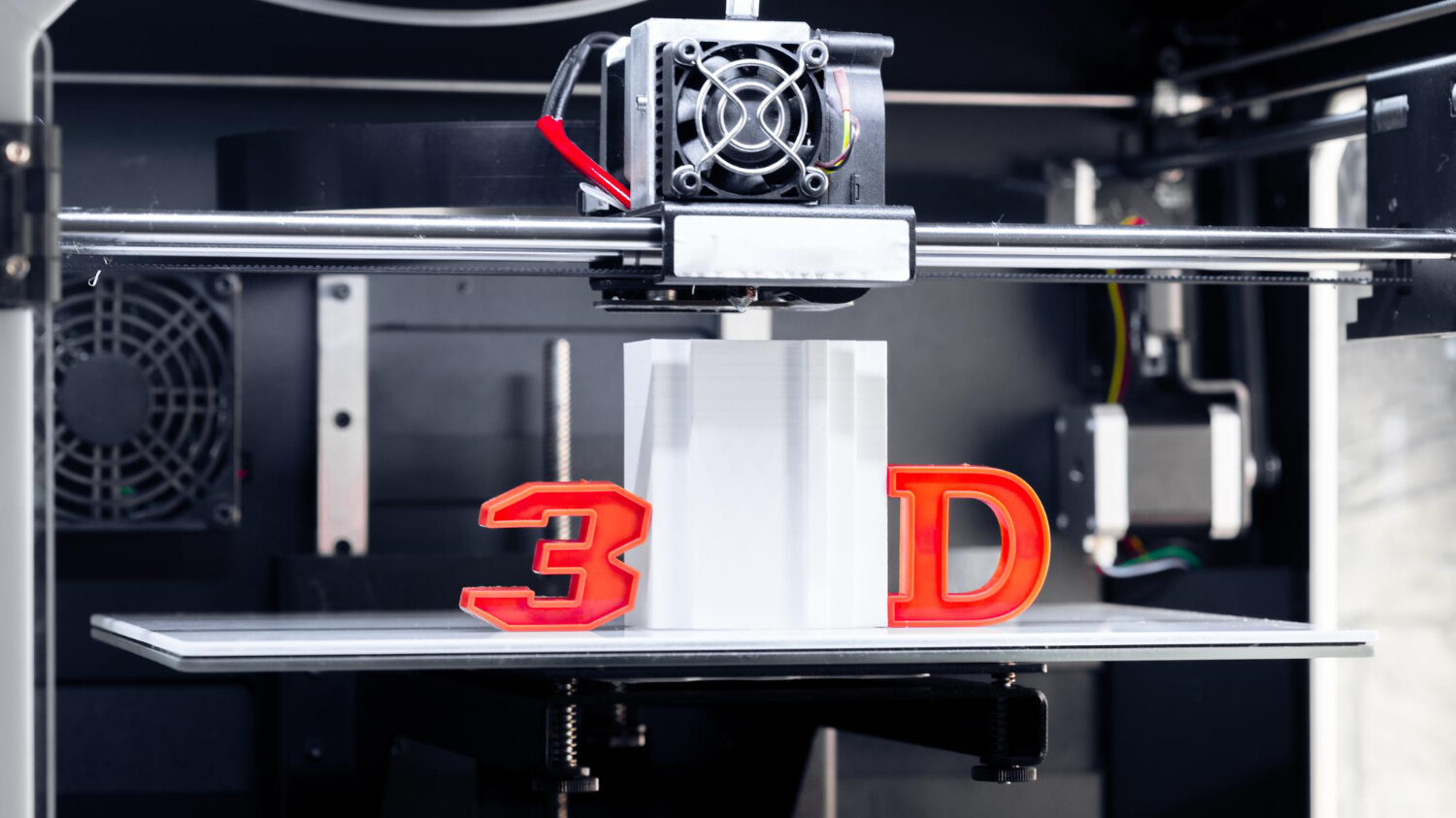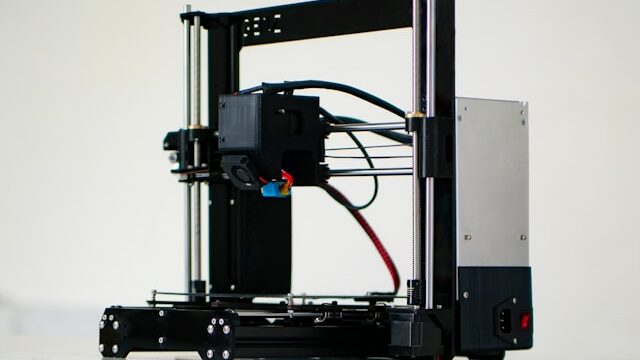Are you wondering about large-format 3D printing and the possibilities it can offer? At Imprimy, we are here to answer all your questions.
Large-format 3D printing allows you to create large-scale objects using a variety of materials, suitable for the industrial, architectural, and design sectors.

What is large-format 3D printing?
Large-format 3D printing is an additive manufacturing technology that makes it possible to produce large-sized objects by layering various materials such as plastic, resin, or concrete. It is used in fields like industry, architecture, and design.
- What is large-format 3D printing?
- What Are the Technologies Used in Large-Format 3D Printing?
- What Are the Advantages of Large-Format 3D Printing?
- What Are the Applications of Large-Format 3D Printing?
- What Are the Limitations of Large-Format 3D Printing?
- What Is the Future of Large-Format 3D Printing?
- Conclusion: Large Format 3D Printing
The definition of large-format 3D printing
Large-format 3D printing is an additive manufacturing process that enables the creation of large-scale objects by layering materials, typically plastic, metal, or composite, based on a digital model. Unlike desktop 3D printers, large-format 3D printers are designed to produce significant-sized parts, often used in demanding industries.
This technology offers significant advantages in terms of customization, rapid prototyping, and on-demand production, making it possible to create complex and custom-made structures that would be difficult or impossible to manufacture using traditional methods.
The Differences Between Large-Format 3D Printing and Traditional 3D Printing
Large-format 3D printing differs from traditional 3D printing mainly in the size of the objects produced. While traditional 3D printers are limited to small-scale items, suitable for desktop or home use, large-format 3D printers can manufacture parts several meters in size — or even larger. This capability greatly expands the range of possible applications, especially in industries requiring large-scale structures, such as architecture, aerospace, and automotive.
In addition, large-format 3D printers often use advanced technologies and specialized materials to ensure the stability and precision of large printed parts. However, these printers typically require greater investment in terms of cost and space, and they may present increased technical challenges compared to desktop 3D printers.
What Are the Technologies Used in Large-Format 3D Printing?
The main technologies used in large-format 3D printing include Fused Deposition Modeling (FDM) for polymers, Stereolithography (SLA) and Digital Light Processing (DLP) for resin, Selective Laser Sintering (SLS) for powders, as well as extrusion printing for materials like concrete or composites.
Large-Format FDM 3D Printing
Large-format FDM 3D printing (Fused Deposition Modeling) is a 3D printing technique that uses the principle of melted material deposition to layer material and create large-scale objects. In this process, a filament—usually a plastic such as ABS or PLA—is heated and extruded layer by layer through a nozzle to build the desired object.
Large-format FDM printers are capable of producing large parts, sometimes several meters in size, making them ideal for applications that require large structures, such as architectural prototypes, automotive parts, or furniture components.
This technology is valued for its simplicity and relatively low cost compared to other 3D printing methods, although it may have limitations in terms of precision and surface quality for highly detailed parts.
Large-Format SLA 3D Printing
Large-format SLA 3D printing (Stereolithography) is a 3D printing technique that uses photopolymerization to create large-scale objects with high precision. Unlike FDM printing, SLA printing uses an ultraviolet laser to cure a photosensitive liquid resin layer by layer, allowing the production of parts with fine details and smooth surfaces.
Large-format SLA printers can produce very large objects, making them especially suitable for applications requiring high precision and excellent surface quality, such as industrial prototypes, architectural models, or artistic pieces.
Other Technologies Used in Large-Format 3D Printing
In addition to FDM and SLA technologies, several other methods are used in large-format 3D printing. Among them:
- Directed Energy Deposition (DED), which uses a concentrated energy beam to melt and deposit material, often metal, layer by layer. This method is ideal for repairing or adding material to existing structures.
- Selective Laser Sintering (SLS), which uses a laser to fuse powder layers, typically metal or plastic, allowing the creation of strong and functional objects.
- Binder Jetting, a technique in which a binding agent is sprayed onto a powder layer to solidify the material, often used for metal or ceramic parts.
What Are the Advantages of Large-Format 3D Printing?
The main advantages of large-format 3D printing include the rapid production of large parts, the reduction of production costs, and the customization of designs.
The Speed and Flexibility of Large-Format 3D Printing
Large-format 3D printing stands out from other forms of 3D printing due to its speed and flexibility, offering significant benefits across various industrial sectors. This technology’s speed allows you to drastically reduce production times by moving directly from a digital model to a physical object without the need for specific tooling.
This advantage is especially valuable for rapid prototyping and on-demand production, where design changes can be quickly implemented. The flexibility of large-format 3D printing lies in its ability to create complex and customized shapes that would be difficult or impossible to produce using traditional manufacturing methods.
Large-format 3D printing enables you to quickly meet your clients’ specific needs, adapt to market changes, optimize material usage, and reduce waste generation.
The Customization of Large-Format 3D Printing
Customization is one of the main strengths of large-format 3D printing, allowing the creation of unique and tailor-made objects that precisely meet the specific needs of your clients or projects.
Thanks to this technology, you can produce parts with complex shapes and personalized details without the constraints of traditional manufacturing methods. This opens the door to a variety of applications, such as the production of custom medical prosthetics, the creation of designer furniture, or the making of unique architectural prototypes.
The customization offered by large-format 3D printing also helps reduce your costs related to small batch or one-off production, while providing great design freedom and fostering innovation across various industrial sectors.
Cost Reduction Thanks to Large-Format 3D Printing
Large-format 3D printing offers significant advantages in terms of customization and cost reduction. Customization is one of the main strengths of this technology, allowing the creation of unique, tailor-made objects that precisely meet the specific needs of customers.
Whether for prototypes, replacement parts, or architectural elements, 3D printing enables the production of complex and individualized shapes without the constraints of traditional manufacturing methods. Regarding cost reduction, large-format 3D printing eliminates the need for expensive tooling and specific molds, thereby lowering initial production costs.
Additionally, it provides optimal material usage, minimizing waste and associated costs. Your ability to produce on demand also avoids excess inventory, contributing to more efficient resource management and an overall reduction in production costs.
What Are the Applications of Large-Format 3D Printing?
The various applications of large-format 3D printing include architecture, industry, design, automotive, aerospace, and construction.
Large-Format 3D Printing in Architecture and Construction
Large-format 3D printing is revolutionizing the architecture and construction sectors by offering innovative and efficient solutions in:
- Architecture: This technology allows the creation of detailed models and scaled prototypes, making it easier to visualize and plan projects. Architects can explore complex and customized designs that would be difficult to achieve with traditional methods.
- Construction: Large-format 3D printing enables the production of structural elements such as walls, beams, and even entire buildings, reducing construction times and labor costs.
This approach also allows for optimal material use, minimizing waste and promoting more sustainable construction practices. Moreover, the ability of these large-format 3D printers to produce custom components directly on-site offers increased flexibility and a rapid response to the specific needs of projects.
Large-Format 3D Printing in the Automotive Industry
Large-format 3D printing plays a transformative role in the automotive industry by offering fast and flexible solutions for the manufacture of complex and customized parts.
This technology enables the production of functional prototypes and large-scale production parts, thereby reducing development times and associated costs. Automotive manufacturers use large-format 3D printing to create lightweight and optimized components, improving the energy efficiency of vehicles.
Additionally, it allows for mass customization, enabling manufacturers to meet specific customer demands with tailor-made parts. Large-format 3D printing also facilitates on-demand production of replacement parts, reducing inventory and waiting times.
Large-Format 3D Printing in Art and Design
Large-format 3D printing opens up new possibilities in art and design, allowing creators to explore novel shapes and structures. Artists and designers use this technology to produce large-scale artworks and installations, pushing the limits of traditional techniques.
3D printing enables the creation of complex and customized designs with a level of precision and repeatability that is difficult to achieve manually. It also offers the ability to create rapid prototypes to test and refine concepts before final production.
By integrating large-format 3D printing, artists and designers can push the boundaries of creativity while benefiting from increased flexibility and cost reduction in producing unique pieces or small series.
Large-Format 3D Printing in Aerospace
Large-format 3D printing plays a crucial role in the aerospace industry by enabling the manufacture of complex and lightweight components essential for aircraft and space vehicles.
This technology allows the production of custom parts with high precision, meeting the sector’s strict performance and safety requirements. Large-format 3D printing is used to create lightweight and optimized structures, reducing the total weight of aircraft and improving their energy efficiency. It also facilitates on-demand production of replacement parts, reducing lead times and inventory costs.
By integrating large-format 3D printing, aerospace companies can innovate faster, improve the flexibility of their supply chain, and respond to the specific needs of their projects with increased responsiveness.
What Are the Limitations of Large-Format 3D Printing?
The main limitations of large-format 3D printing are the longer printing time, the high cost of machines and materials, precision constraints, sometimes lower mechanical strength compared to traditional methods, and challenges related to the post-processing of large parts.
The High Initial Cost of Large-Format 3D Printers
The high purchase cost of large-format 3D printers is a major challenge for companies looking to adopt this technology. The investment required to acquire these machines is often substantial due to their technical complexity and their capacity to produce large objects. This cost includes not only the equipment purchase but also the necessary infrastructure, software, and staff training for optimal use.
However, despite this initial investment, large-format 3D printers offer long-term benefits, including production cost reduction, improved efficiency, and increased flexibility in manufacturing complex and customized parts. Companies must therefore weigh these potential benefits against the initial costs to determine the viability of this technology in their operations.
Materials Compatible with Large-Format 3D Printing
Large-format 3D printing is limited to certain materials, which nevertheless offer considerable flexibility for various industrial applications.
Commonly used materials include:
- Plastics such as ABS, PLA, and PETG, valued for their lightweight nature and ease of use.
- Photosensitive resins used in technologies like SLA for high-precision parts with smooth surfaces.
- Metals, notably aluminum, titanium, and alloys, employed for components requiring high strength and durability, often in the aerospace and automotive sectors.
- Composites and ceramics, used for applications requiring specific properties such as heat resistance or lightweight characteristics.
The choice of material depends on the specific requirements of the project, such as mechanical strength, durability, and environmental constraints.
Quality and Precision of Large-Format 3D Prints
The quality and precision of large-format 3D prints are crucial factors that determine the efficiency and viability of this technology across various industrial sectors. Large-format 3D printers are capable of producing parts with high resolution and fine details, thanks to technological advances such as SLA and SLS, which provide smooth surfaces and precise dimensional tolerances.
However, quality can vary depending on several factors, including the type of material used, the complexity of the design, and the printing parameters. To achieve optimal results, it is essential to properly calibrate the machines and control environmental conditions during the printing process. Additionally, post-processing techniques may be required to enhance the finish of printed parts, ensuring they meet the specific requirements of industrial applications.
What Is the Future of Large-Format 3D Printing?
The future of large-format 3D printing relies on the improvement of materials, the increase in printing speed, the automation of processes, the integration into sustainable construction, and its growing adoption in the aerospace, automotive, and industrial design sectors.
Future Trends in Large-Format 3D Printing
The future trends of large-format 3D printing promise to further expand the possibilities of this technology, addressing the growing needs of various industrial sectors.
Among the emerging trends, there is a continuous improvement in precision and printing speed, enabling the production of increasingly detailed parts in a shorter time. The integration of artificial intelligence (AI) and machine learning into the design and manufacturing processes will optimize the performance and efficiency of prints. The use of new advanced materials, such as biomaterials and smart composites, will open the way for innovative applications in medicine, sustainable architecture, and aerospace.
Additionally, 4D printing, which allows printed objects to change shape or function in response to external stimuli, is another promising trend. Finally, the growing adoption of 3D printing in mass production and large-scale customization will transform supply chains, making manufacturing processes more flexible and sustainable. These advances will contribute to wider adoption and deeper integration of large-format 3D printing across various industrial sectors.
Upcoming Innovations for Large-Format 3D Printing
Upcoming innovations in large-format 3D printing promise to further revolutionize this technology, opening new perspectives for various industrial sectors. Among the expected advances are the development of advanced materials, such as nanomaterials and smart composite materials, which will offer improved properties in terms of strength, lightweight, and functionality.
The integration of sensors and printed electronics will enable the creation of smart structures capable of monitoring their own condition and reacting to their environment. Multi-material printing will become more common, allowing the combination of different materials within the same part for optimized performance. Automation will play a key role in optimizing manufacturing processes, reducing errors, and improving efficiency.
Additionally, in situ 3D printing, where structures are printed directly on site, will transform the construction and infrastructure industries, enabling better waste reduction. These innovations will contribute to a wider adoption of large-format 3D printing, making the technology more accessible, efficient, and sustainable.
Conclusion: Large Format 3D Printing
Large-format 3D printing represents a major advancement in the field of additive manufacturing, offering innovative and flexible solutions for various industrial sectors.
Thanks to its ability to produce large-sized parts with high precision, this technology pushes the boundaries of creativity and efficiency. Large-format 3D printing enables mass customization, cost reduction in production, and material optimization, thus contributing to more sustainable practices. Future innovations, such as the integration of artificial intelligence, the development of new materials, and multi-material printing, promise to further expand the applications of large-format 3D printing.
However, high initial costs and technical challenges must be overcome to allow for broader adoption. Ultimately, large-format 3D printing is poised to transform supply chains and manufacturing processes, paving the way for a new era of flexible and personalized production.
Picture by fabrikasimf via Freepik.
The articles published on Imprimy.com are for informational purposes only. They are intended to provide general advice and information related to 3D printing. Imprimy.com cannot be held responsible for the results obtained or the consequences arising from the application of the shared information. We recommend always checking the specific instructions for your hardware and materials before use.


